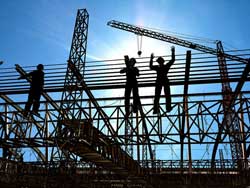Workplace Safety Expert Clarifies Federal Fall Protection Requirements for Construction Sites

24 hour fall prevention training class
Federal OSHA and EM-385-1-1- Rules Differ
Accidental falls are the leading cause of death on construction sites. And not surprisingly, OSHA issues more citations for violations of their fall protection standards than any other category”
ARLINGTON, TX, USA, July 12, 2022 /EINPresswire.com/ -- Most employers are aware there are mandatory fall protection regulations that apply to their construction sites. However, according to Curtis Chambers, a nationally recognized workplace safety expert and President of OSHA Training Services Inc., many employers and their designated Competent Person do not realize there are differing rules depending on which Federal regulatory body has jurisdiction over the construction site.— Curtis Chambers, President - OSHA Training Services Inc.
“Federal OSHA 1926 Construction Fall Protection Requirements in Subpart M apply to contractors working on construction sites regulated by the Federal Occupational Safety and Health Administration (aka OSHA)” says Mr. Chambers. “And the EM-385-1-1 Fall Protection Requirements apply to workers on job sites regulated by the US Army Corp of Engineers (USACE). Many of these two organizations’ fall protection-related standards are the same or substantially similar. However, there are a few important differences within these two sets of standards that are often overlooked”. Mr. Chambers provides the following non-exhaustive overview of the major differences between those fall protection regulations below:
• Federal OSHA 1926 Subpart M construction fall protection standards generally require construction workers to be provided with some form of fall protection (e.g.: guardrails, safety nets, personal fall arrest system . . .) when exposed to falls of six (6) or more feet. Other Federal OSHA standards have different requirements for the use of fall protection for construction workers who are on a scaffold platform (10-foot threshold for fall protection) and iron-workers involved in erecting steel activities (15 threshold for most activities, 30 feet for connectors in certain instances). However, the EM-385 rules followed on US Army Corp of Engineer job-sites applies the six (6) foot fall protection rule to most all workers on their worksites, including workers using scaffold and those involved in iron-working activities at or above the six (6) foot threshold.
• Another commonly overlooked difference between these two sets of rules is that Federal OSHA construction standards require use of a body belt and lanyard by workers in extensible boom lifts. But Federal OSHA does not require, or even address, the use of a body belt for workers in scissor lifts. But the EM-385 rules do state that employees in both an aerial lift as well as in a scissor lift be required to wear a body belt or harness equipped with a lanyard short enough to prevent them from falling out of, or being thrown from, the work platform.
• One other primary difference between these two sets of fall protection standards is that the Federal OSHA fall protection standards have a non-specific rule simply stating that employers must provide for timely rescue of employees who have fallen and are suspended in a full body harness. However, the more detailed EM-385 rule applicable to the US Army Corp of Engineer job-sites actually requires the employer to develop and have available a detailed, site-specific fall protection plan which includes written procedures (which are not required by OSHA) to be used for fallen worker rescue.
Mr. Chambers goes on to reveal that accidental falls are the leading cause of death on construction sites. And not surprisingly, OSHA issues more citations for violations of their fall protection standards than any other category. Therefore, he urges employers to provide comprehensive fall protection training for the designated Competent Person at their construction sites. Also, employers are encouraged to refer to the Federal OSHA 1926 construction standards and the US Army Corp of Engineers EM-385-1-1- standards for full details about their respective fall protection requirements.
About OSHA Training Services Inc.: OSHA Training Services Inc. conducts on site OSHA training classes for groups of workers for employers located anywhere in the United States. They also offer online training courses on major general industry and construction topics, including the RMOL 0113 24-hour fall protection training course designed for the Competent Person in charge of fall protection at the construction site, as well as the EM-385-1-1 course for construction.
Curtis Chambers
oshatraining.com
+1 817-691-8721
email us here
Visit us on social media:
Facebook
Twitter
